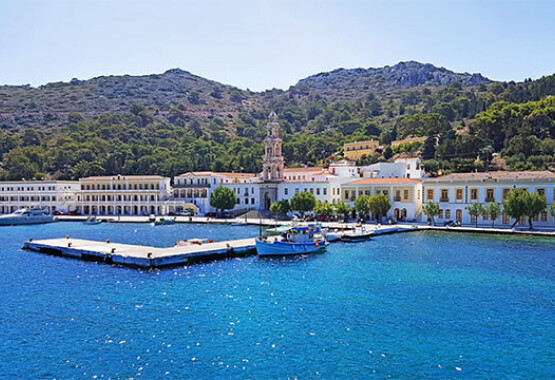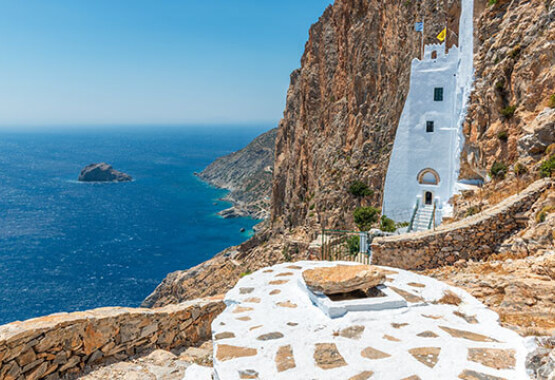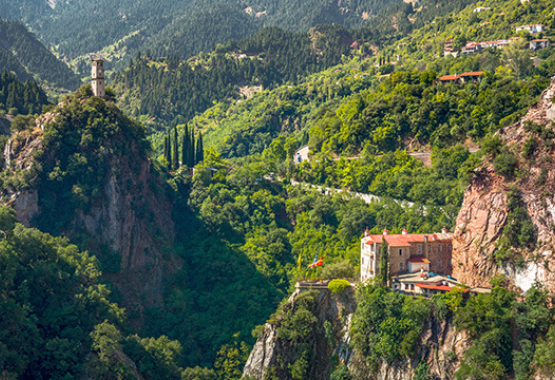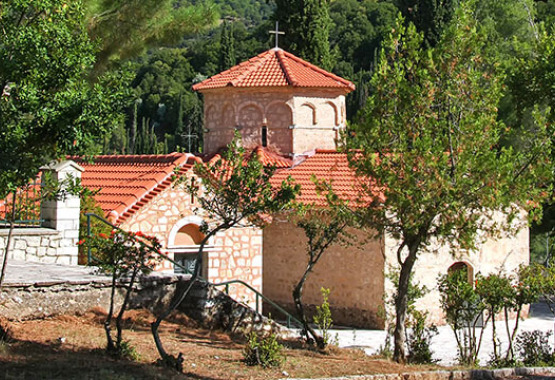
ARACHOVA
The two churches of the monastic complex are built next to each other, with access between them through a passage. The older church is the Church of Virgin Mary, dating back to the mid-10th century AD, while the larger church, built in the early 11th century AD, is dedicated to the founder, Saint Loukas. The Church of Virgin Mary is a masterpiece of Byzantine architecture, exemplifying the “cloisonné” style of masonry, where ashlar blocks of stone are surrounded by bricks forming decorative lines and motifs. This church became the prototype for all the classical Byzantine churches in southern Greece.
If the church of the Virgin Mary impresses us with its external appearance, the Katholicon of the monastery surprises us with the multicoloured marble revetments, while the ceilings are illuminated by the mosaics with the golden background (11th century AD). The scenes are religious, chosen and designed according to the strict rules followed by the artists until nowadays. Byzantine painting does not imply strictness and lack of movement. Byzantine artists never ceased to draw inspiration from ancient art, embracing its harmonious proportions and elegance. Byzantine art is the only form of European art that began at the end of antiquity and concluded with the Renaissance, effectively bringing the ancient world in recent history.
Monastery of Hosios Loukas
Byzantine Masterpieces at the foot of Mountain Parnassos
On your way up to the slopes of Mt. Parnassos and the archaeological site of Delphi, you'll come across the village of Distomo and Styri. Located about 13 km before the town of Arachova, this area is home to one of the most impressive monuments in the Mediterranean Sea: the monastery of Hosios Loukas. Nestled in a picturesque valley teeming with olive trees, this Byzantine monastery exemplifies the tradition of being built in sites of extraordinary natural beauty, harmonizing seamlessly with the surrounding landscape, much like the ancient temples.View from Hosios Loukas, Greece
In a landscape untouched by time, you will see two magnificent Byzantine churches adorned with frescoes and mosaics featuring a characteristic golden background from the 10th - 11th century AD. The monastery's Byzantine splendour, still functioning today, was recently revealed through a successful restoration project. Founded around the mid - 10th century AD by the monk Loukas from Styri, the monastery showcases his relics in the Katholicon (main church). These relics were stolen by the Crusaders in the 13th century AD and kept in the Vatican for centuries before being returned.The two churches of the monastic complex are built next to each other, with access between them through a passage. The older church is the Church of Virgin Mary, dating back to the mid-10th century AD, while the larger church, built in the early 11th century AD, is dedicated to the founder, Saint Loukas. The Church of Virgin Mary is a masterpiece of Byzantine architecture, exemplifying the “cloisonné” style of masonry, where ashlar blocks of stone are surrounded by bricks forming decorative lines and motifs. This church became the prototype for all the classical Byzantine churches in southern Greece.
If the church of the Virgin Mary impresses us with its external appearance, the Katholicon of the monastery surprises us with the multicoloured marble revetments, while the ceilings are illuminated by the mosaics with the golden background (11th century AD). The scenes are religious, chosen and designed according to the strict rules followed by the artists until nowadays. Byzantine painting does not imply strictness and lack of movement. Byzantine artists never ceased to draw inspiration from ancient art, embracing its harmonious proportions and elegance. Byzantine art is the only form of European art that began at the end of antiquity and concluded with the Renaissance, effectively bringing the ancient world in recent history.




